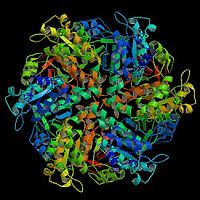
Photo from wikipedia
In eukaryotic cells, the spatial organization of genes within the nucleus is correlated with their expression. However, correlation is not causa-tion. To determine how nuclear spatial organization affects gene expression,… Click to show full abstract
In eukaryotic cells, the spatial organization of genes within the nucleus is correlated with their expression. However, correlation is not causa-tion. To determine how nuclear spatial organization affects gene expression, Di Stefano et al. studied... The three-dimensional (3D) organization of chromosomes can influence transcription. However, the frequency and magnitude of these effects remain debated. To determine how changes in chromosome positioning affect transcription across thousands of genes with minimal perturbation, we characterized nuclear organization and global gene expression in budding yeast containing chromosome fusions. We used computational modeling and single-cell imaging to determine chromosome positions, and integrated these data with genome-wide transcriptional profiles from RNA sequencing. We find that chromosome fusions dramatically alter 3D nuclear organization without leading to strong genome-wide changes in transcription. However, we observe a mild but significant and reproducible increase in the expression of genes displaced away from the periphery. The increase in transcription is inversely proportional to the propensity of a given locus to be at the nuclear periphery; for example, a 10% decrease in the propensity of a gene to reside at the nuclear envelope is accompanied by a 10% increase in gene expression. Modeling suggests that this is due to both deletion of telomeres and to displacement of genes relative to the nuclear periphery. These data suggest that basal transcriptional activity is sensitive to radial changes in gene position, and provide insight into the functional relevance of budding yeast chromosome-level 3D organization in gene expression.
Journal Title: Genetics
Year Published: 2020
Link to full text (if available)
Share on Social Media: Sign Up to like & get
recommendations!